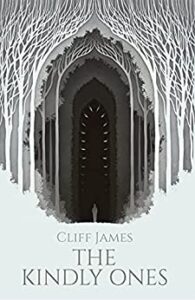The Kindly Ones by Cliff James
Lethe Press, 2021
ISBN: 2370000883131
Available: paperback, Kindle
The Kindly Ones is not your standard horror novel. No fast pacing. No big thrills. No wild climax, where all is explained. Instead, it’s a dark, brooding tale that relies heavily on atmosphere, a methodical pace, and excellent writing to pull the reader in, and it does it very well. Fans of Robert Eggers’s films (The Witch, The Lighthouse) will love this book, as well as anyone who enjoys a story outside the norm.
After The Calamity, (world apocalypse) the story centers on two small groups of people trying to eke out an existence in a remote forest, away from the remains of humanity. One is the uber-religious Mann family, consisting of Mother and her sons. The other is a group of more socially permissive people: Rhea, Fran, Ky, (female) and the youngest, teen-age Lugh (male). Conflict eventually ensues, since the groups have very contrasting worldviews, especially when it concerns the intimate relationship between Lugh and Abel, one of Mother’s sons. There’s another plot thread concerning the reclusive Father Ambrose, who lives alone in a mansion nearby. It becomes clear that one group must prove superior, so the other group has to be driven out, or eliminated.
Instead of opting for a story arc with peaks and valleys, the book opts for a slow, calculated pace, and relies on creating an overall atmosphere of unease that persists throughout the story, and it does it extremely well. Much of it is due to the author’s phenomenal way with words; the writing is art in story form. If the 19th century masters of British literature had decided to go wild and write horror, The Kindly Ones is what one of them might have produced. However, like reading Dickens, this is best read slow, so nothing is missed and the author’s meaning is understood. Example: “and power was given to kill with sword, and with hunger, and with death”, he said, heaving the axe into the air, over his head, onto hers, “and to kill with the beasts of the earth.” It’s easy to miss that someone just got an axe slammed into their head, if you are turning the pages too fast! The book is an AP course on how to write well, and could be enjoyed for that alone.
Incredible writing aside, The Kindly Ones is still a good enough story that most readers should enjoy and appreciate it. As noted, the plot isn’t fast, but moves at a measured, steady pace, although it might be too slow for thrill readers. It relies upon small happenings to move the story, and leaving parts deliberately vague helps add to the mystery of the story. For example, are The Kindly Ones real monsters in the woods, or are the Mann family members the actual monsters? How did Father Ambrose wind up in the mansion by himself? What’s with the wild-haired guy with goats who shows up on rare occasions? Instead of answering, the author chose to provide the situations and let the reader draw their own conclusions. Leaving plot threads open-ended can help or hurt a story, in this case it enhances it. There’s no real conclusive ending, it just…ends, leaving open possibilities for the reader to think about.
If you’re looking for an unusual book that paints a picture instead of just telling a story, The Kindly Ones is for you. Recommended.
Reviewed by Murray Samuelson











Follow Us!